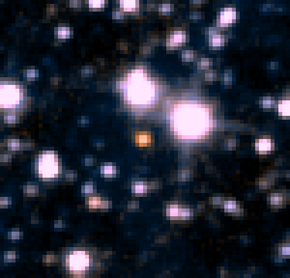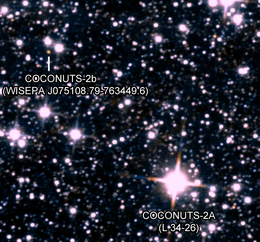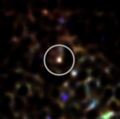COCONUTS-2b
 COCONUTS-2b with unWISE. The planet in the center of the image stands out due to its red color. The host star is not pictured here. | |
| Discovery | |
|---|---|
| Discovered by | Zhoujian Zhang Michael Liu Zach Claytor William Best Trent Dupuy Robert Siverd[1] |
| Discovery date | August 2011 (as a free-floating brown dwarf)[2]
|
| Direct imaging | |
| Designations | |
| WISEPA J075108.79-763449.6[2] | |
| Orbital characteristics | |
| 7,506+5,205 −2,060 AU[4] (1.123×1012 km) | |
| 1.1+1.3 −0.4×106[4] years | |
| Star | L 34-26 |
| Physical characteristics | |
| 1.11+0.03 −0.04 RJ[5] | |
| Mass | 8±2 MJ[5] |
| log(g) = 4.19+0.18 −0.13 cgs[5] | |
| Temperature | 483+44 −53 K[5] |
Spectral type | T9.5±0.5[5] |
COCONUTS-2 b is a gas giant exoplanet that orbits the M-type star L 34-26. With a mass of 8 Jupiters,[5] it takes over one million years to complete one orbit around the star orbiting 7,506 AU away from it.[1]
The planet was discovered in 2011 and was initially identified as a T9 free-floating brown dwarf WISEPA J075108.79−763449.6.[2] During the COol Companions ON Ultrawide orbiTS (COCONUTS) survey, its association with L 34-26 was announced in 2021.[6] At a distance of 35.5 light-years (10.9 parsecs), COCONUTS-2b was the closest directly imaged exoplanet to Earth[7] until Epsilon Indi Ab was imaged in 2024.
Proposed formation scenarios
The researchers found that it is unlikely that COCONUTS-2b was formed inside the protoplanetary disk of the host star and it is more likely that the planet formed on its own via high entropy formation (aka hot-start process).[4][8]
The peculiar properties of COCONUTS-2b could be explained with different scenarios as proposed by Marocco et al. in 2024. The properties could be explained by a non-solar carbon-to-oxygen ratio, meaning that it formed inside a disk around L 34–26. In this scenario the most likely way COCONUTS-2b got in a higher orbit is by a stellar fly-by of two binaries or two planetary systems. In the second scenario L 34-26 is not actually young, but mimics youth due to tidal and/or magnetic interactions with an unseen companion. In this scenario COCONUTS-2b would be an old brown dwarf. In a third scenario COCONUTS-2b could be a captured old brown dwarf. This is however seen as unlikely due to the stellar fly-by requiring a low velocity.[9]
Another study found that their preferred model showed a metallicity that is lower than the host star, which is inconsistent with in-situ binary-like formation. Only their third-preferred model is consistent with a binary-like formation, because in this model the metallicity of host star and planet agreed.[5]
Atmosphere
The planet's spectral type suggests high amounts of methane, water vapor and low amounts of carbon monoxide in the atmosphere of COCONUTS-2b. It might also have both clouds and a non-equilibrium process in its atmosphere.[2][4]
Due to its large orbital separation, COCONUTS-2b is a great laboratory to study the atmosphere and composition of young gas-giant exoplanets.[3] Astronomers estimate the planet's temperature to be around 434 K (161 °C; 322 °F).[4]
Observations with Gemini/Flamingos-2 showed a spectral type of T9.5±0.5, near the T/Y transition. The spectrum is also more consistent with disequilibrium chemistry and the presence of clouds. Additionally the atmosphere shows a diabatic thermal structure, meaning the pressure-temperature profile is non-adiabatic. Adiabatic means here an increase of the temperature with pressure. The observation also indicate a sub- or near-solar metallicity.[5]
Host star
| Observation data Epoch J2000.0 Equinox J2000.0 | |
|---|---|
| Constellation | Chamaeleon |
| Right ascension | 07h 49m 12.678s[10] |
| Declination | −76° 42′ 06.72″[10] |
| Apparent magnitude (V) | 11.3[11] |
| Characteristics | |
| Evolutionary stage | Red dwarf |
| Spectral type | M3V[11] |
| Astrometry | |
| Radial velocity (Rv) | 1.19±0.61[12] km/s |
| Proper motion (μ) | RA: -102.154 mas/yr[10] Dec.: -192.918 mas/yr[10] |
| Parallax (π) | 91.8263 ± 0.0185 mas[10] |
| Distance | 35.519 ± 0.007 ly (10.890 ± 0.002 pc) |
| Details | |
| Mass | 0.37±0.02[4] M☉ |
| Radius | 0.388±0.011[4] R☉ |
| Temperature | 3,406±69[4] K |
| Age | 150–800[4] Myr |
| Other designations | |
L 34-26, COCONUTS-2A, WISEPA J075108.79-763449.6, 1RXS J074912.9-764202, 2MASS J07491271-7642065, NLTT 18592, TIC 272232401, TYC 9381-1809-1, UCAC4 067-006518 | |
| Database references | |
| SIMBAD | data |
L 34–26, also known as COCONUTS-2A and TYC 9381–1809–1, is a M3-type dwarf star located 35 light-years away, in the constellation of Chamaeleon. The star is about one-third the mass of the Sun, with an age between 150 and 800 million years old.[13]
Researchers using TESS found that L 34-26 showed stellar flares about every 0.48 days. It was the most active planet hosting star in their sample. The team studying the host star also found that L 34-26 is fast rotating with a rotation period of 2.83 days. The planet should not be influenced by the flares, because of the large orbital separation.[14] The star is seen almost equator-on with i = 81.8±5.8 deg and might belong to the proposed Ursa Major corona, which is 400 million years old.[9]
Gallery
-
The COCONUTS-2 system with unWISE
-
The planet COCONUTS-2b with Gemini-South
-
Allwise image by the discoverers, showing planet COCONUTS-2b
References
- ^ a b "Massive COCONUTS exoplanet discovery led by UH grad student | University of Hawaiʻi System News". University of Hawaiʻi News. University of Hawaiʻi at Mānoa. Archived from the original on 15 December 2021. Retrieved 21 December 2021.
- ^ a b c d Kirkpatrick, J. Davy; Cushing, Michael C.; Gelino, Christopher R.; Griffith, Roger L.; Skrutskie, Michael F.; Marsh, Kenneth A.; Wright, Edward L.; Mainzer, A.; Eisenhardt, Peter R.; McLean, Ian S.; Thompson, Maggie A.; Bauer, James M.; Benford, Dominic J.; Bridge, Carrie R.; Lake, Sean E. (2011-12-01). "The First Hundred Brown Dwarfs Discovered by the Wide-field Infrared Survey Explorer (WISE)". The Astrophysical Journal Supplement Series. 197 (2): 19. arXiv:1108.4677. Bibcode:2011ApJS..197...19K. doi:10.1088/0067-0049/197/2/19. ISSN 0067-0049. S2CID 16850733.
- ^ a b Kooser, Amanda. "Massive exoplanet 'Coconuts-2b' could help reveal the secrets of young gas giants". CNET. Archived from the original on 21 December 2021. Retrieved 21 December 2021.
- ^ a b c d e f g h i Zhang, Zhoujian; Liu, Michael C.; Claytor, Zachary R.; Best, William M. J.; Dupuy, Trent J.; Siverd, Robert J. (2021-08-01). "The Second Discovery from the COCONUTS Program: A Cold Wide-orbit Exoplanet around a Young Field M Dwarf at 10.9 pc". The Astrophysical Journal. 916 (2): L11. arXiv:2107.02805. Bibcode:2021ApJ...916L..11Z. doi:10.3847/2041-8213/ac1123. ISSN 0004-637X.
- ^ a b c d e f g h Zhang, Zhoujian; et al. (2025). "Disequilibrium Chemistry, Diabatic Thermal Structure, and Clouds in the Atmosphere of COCONUTS-2b". The Astronomical Journal. 169 (1) 9. arXiv:2410.10939. Bibcode:2025AJ....169....9Z. doi:10.3847/1538-3881/ad8b2d.
- ^ "Exoplanet-catalog". Exoplanet Exploration: Planets Beyond our Solar System. Archived from the original on 2021-11-22. Retrieved 2021-11-22.
- ^ Siegel, Ethan. "Astronomers Go Nuts For Closest Exoplanet Directly Imaged Ever: COCONUTS-2b". Forbes. Archived from the original on 2021-11-22. Retrieved 2021-11-22.
- ^ Marley, Mark S.; Fortney, Jonathan J.; Hubickyj, Olenka; Bodenheimer, Peter; Lissauer, Jack J. (2007-01-01). "On the Luminosity of Young Jupiters". The Astrophysical Journal. 655 (1): 541–549. arXiv:astro-ph/0609739. Bibcode:2007ApJ...655..541M. doi:10.1086/509759. ISSN 0004-637X. S2CID 7793365.
- ^ a b Marocco, Federico; Kirkpatrick, J. Davy; Schneider, Adam C.; et al. (2024-04-22). "Thirteen New M Dwarf + T Dwarf Pairs Identified with WISE/NEOWISE". The Astrophysical Journal. 967 (2): 147. arXiv:2404.14324. Bibcode:2024ApJ...967..147M. doi:10.3847/1538-4357/ad3f1d.
- ^ a b c d Vallenari, A.; et al. (Gaia collaboration) (2023). "Gaia Data Release 3. Summary of the content and survey properties". Astronomy and Astrophysics. 674: A1. arXiv:2208.00211. Bibcode:2023A&A...674A...1G. doi:10.1051/0004-6361/202243940. S2CID 244398875. Gaia DR3 record for this source at VizieR.
- ^ a b Martin, Pierre-Yves (2021). "Planet COCONUTS-2 b". Extrasolar Planets Encyclopaedia. Retrieved 2023-11-28.
- ^ "Simbad - Object view". simbad.cds.unistra.fr. Retrieved 2023-11-28.
- ^ "Giant Exoplanet Orbits Its Host Star Once Every 1.1 Million Years | Astronomy | Sci-News.com". Breaking Science News | Sci-News.com. Archived from the original on 2021-11-22. Retrieved 2021-11-22.
- ^ Stelzer, B.; Bogner, M.; Magaudda, E.; Raetz, St. (2022). "Flares and rotation of M dwarfs with habitable zones accessible to TESS planet detections". Astronomy and Astrophysics. 665: A30. arXiv:2207.03794. Bibcode:2022A&A...665A..30S. doi:10.1051/0004-6361/202142088. S2CID 249662585.






